Overall this appears to be a fine representation of Quetzalcoatlus in many details, but when it comes to some of this animal’s most integral and challenging features the figurine actually falls short.
Having grown up familiar with the titanic pterosaur being featured in books and television programs, it’s sometimes surprising for me to remember that Quetzalcoatlus is a relatively recent discovery in the history of paleontology. Named after the serpentine feathered Aztec deity, Quetzalcoatlus was found and initially described in 1975; it has retained notoriety for being (probably) the largest flying animal known in all natural history. One might also argue the pterosaur has been notorious in the paleontological community for just how poorly understood it really was until very recent decades, when new and more thorough examinations of Quetzalcoatlus and its relatives, the azhdarchid pterosaurs, have begun unveiling clearer understanding about the appearance and lifestyle of these remarkable flying reptiles. Quetzalcoatlus has also become real-life proof that truth can indeed be stranger than fiction – azhdarchids would have been some of the most alien-looking creatures to patrol the lands and skies of the Cretaceous period.

Even though scientific literature has been lacking in the past, toy companies haven’t hesitated to tackle Quetzalcoatlus in all its mysteriously weird wonder. The most recent company to throw in is GR Toys, a relatively new retail store/sales agent with a handful of PVC figurines and larger, high-end models currently under their belt. These products were produced in collaboration with a couple of other small companies, Haolonggood and MuSee Studios. Following an impressive Spinosaurus by MuSee in 2020, and a highly-regarded pair of Carcharodontosaurus and Dicraeosaurus in 2021 by Haolonggood, GR Toys has collaborated with BOTH companies to produce a PVC figurine, as well as a resin kit, featuring the giant azhdarchid, with the PVC version being their first release of 2022. The initial release of this figure includes two copies of the figure; one is complete and one is unpainted, as a promotional contest for buyers to paint their own figure and send back for judging (the winning prizes include other models by GR/Haolonggood which would normally be more expensive). For this review, I’m focusing on the regular, pre-painted edition of the figure, which is expected to have a separate release in the future.
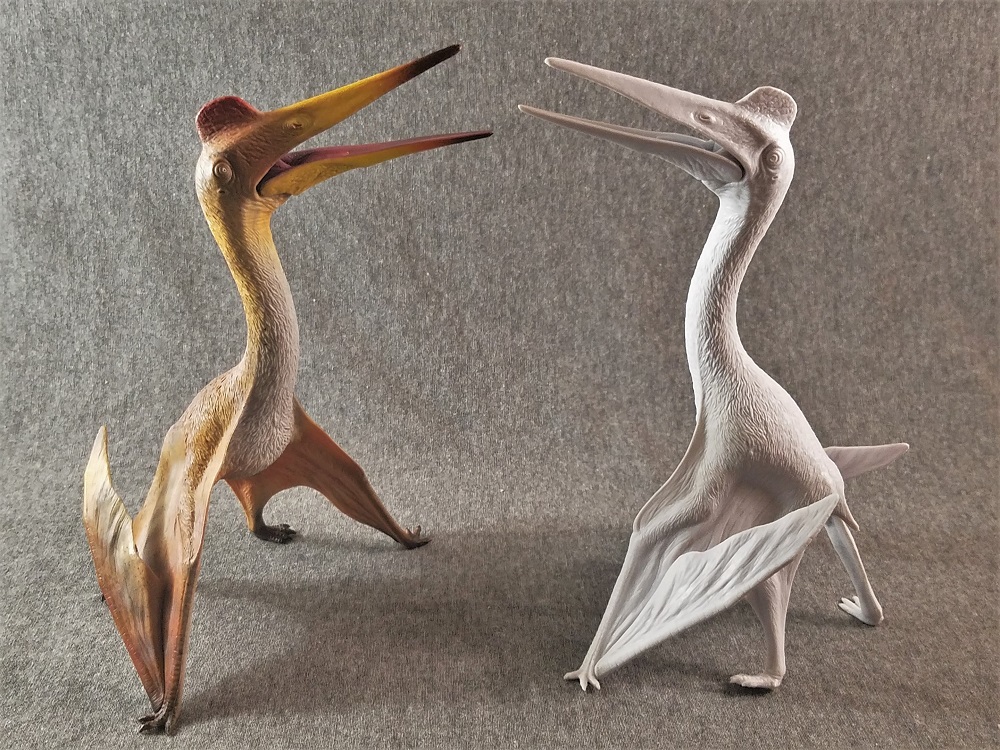
The PVC version of GR Toys’ Quetzalcoatlus is produced by Haolonggood, having followed the larger resin version sold from MuSee studios. It is an imposing figure, labeled as 1:35 scale and measuring 17.5 cm (7 in) tall at the crest. The figure is posed standing tall, legs spread slightly, with the lengthy neck and head tilted up as if scanning the sky or possibly stretching for an intimidation display. It’s a modest, but still dramatic posture, conveying the animal’s size and presence. My figure, worth noting, doesn’t sit squarely on the bottoms of its hands and feet, so the limbs spread a little farther than I think was intended and the figure can end up a hair front-heavy. Hot water treatment can remedy the forelimbs’ posture (at least temporarily), but it might throw off the back feet if one isn’t careful. The figure also features an articulated jaw for additional display options, as is popular with prehistory figurines these days; however the articulation joint on this figure doesn’t seem to be very well-built. The jaw wiggles around in the joint, and tends to hang loose over time if positioned shut. Even the slightest jostle can knock the beak open. This isn’t the first figure GR Toys has released with an articulated jaw, and the basic gimmick has been applied by companies for over a decade now; it’s regrettable to see a brand-new, higher-end figurine still struggling with the application.
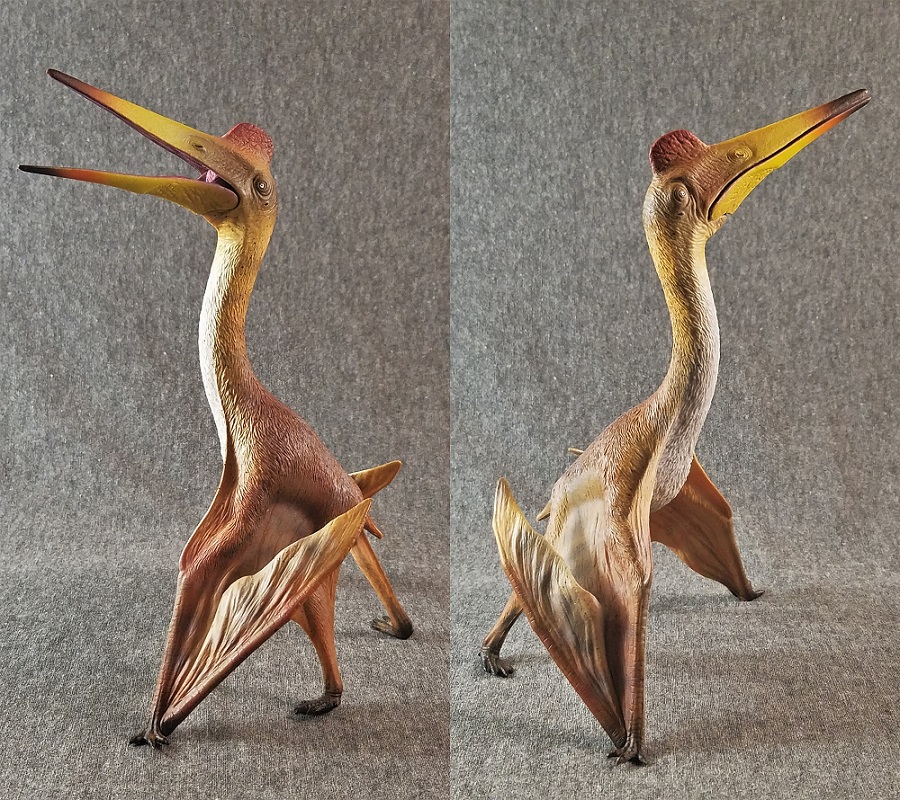
Although the articulated jaw is a letdown, it doesn’t detract from the quality of the main sculpt, which is very good. The smooth, keratinous sheen of the enormous bill transitions smoothly into more textured facial skin, with ringed patterns pronounced around the nostrils and beady eyeballs. Minute ear holes are sculpted in just beneath the eyes, and a rugose texture is applied to the semi-rectangular crest atop the figure’s head. Inside the bill is a tongue and fleshy parts along the roof and back of the mouth. From the neck down over the body, a fine coat of hairy pycnofibers is present with excellent detail; the coat is mostly uniform in length, but subtle variations are apparent along the underside and the limbs. The lower forelimbs are reinforced with a row of large scales, with smaller scales along the fingers and toes. The wing fingers appear to be separate mold pieces from the main body, but the folded texture of the membranes disguises the seams well. The wings of this figure look flexible but firm, worn from many years of flight but as sturdy as ever. GR Toys and Haolonggood have done a splendid job at depicting a living animal.
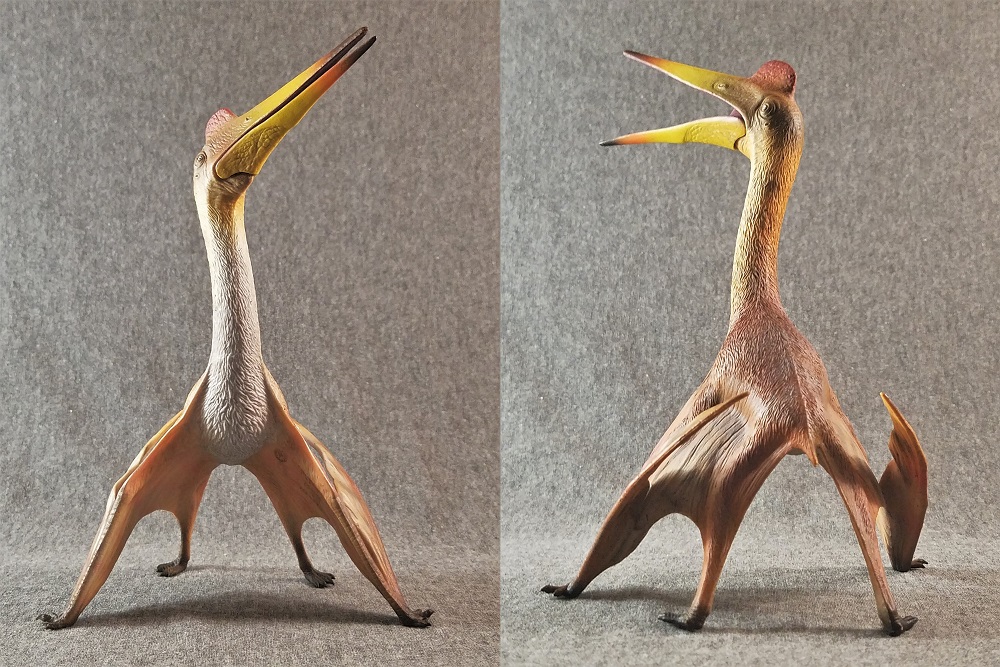
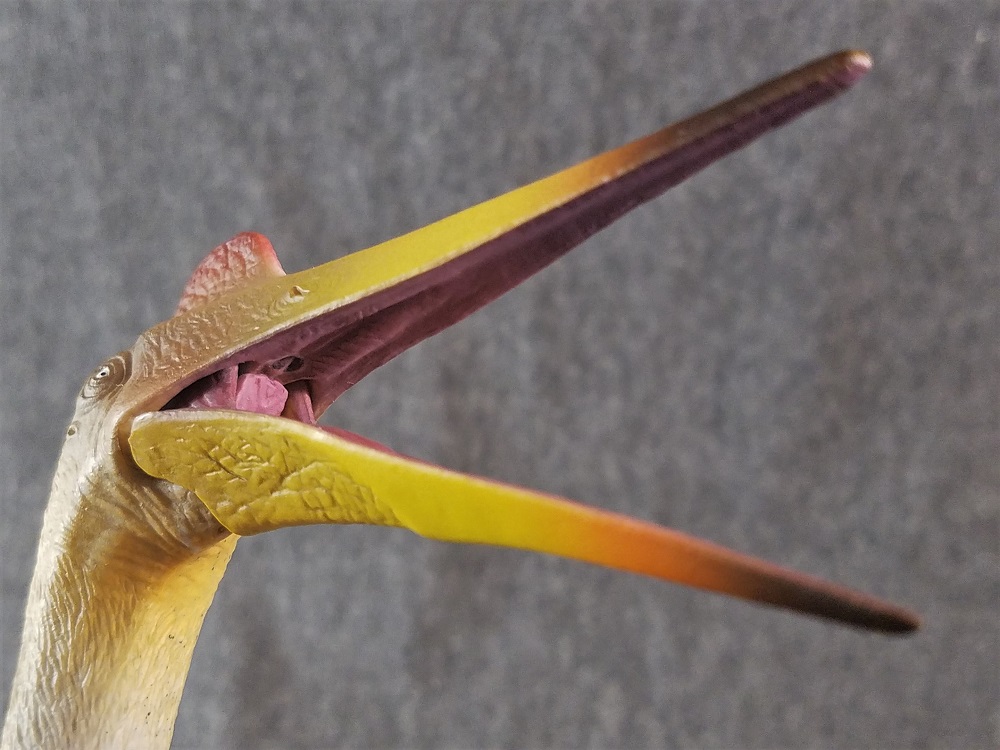
Further complimenting the sculpt is the paint job, which uses a modest blend of mostly light browns and grays with fine application. Subtle dark banding on the neck and wing membranes break up the reddish-tan base, along with a faint smoky-gray wash to the pycnofibers on the back. There are also a few gray arrow-shaped stripes on the back, but they’re not as prominent on my copy as they are in promotional photos. The undersides of the wings take on a light peach hue, which complements the dirty white underbelly and contrasts well with the near-black hands and feet. The most striking features are the bill – bright yellow tipped in a gradient of orange to dark brown – and the red head crest. The eyes, tiny as they are, have also been expertly painted a neat white with dotted black pupils. One can easily draw parallels to the color patterns seen in large ground birds of the prairies and savannahs today; there are no complaints to be had here.
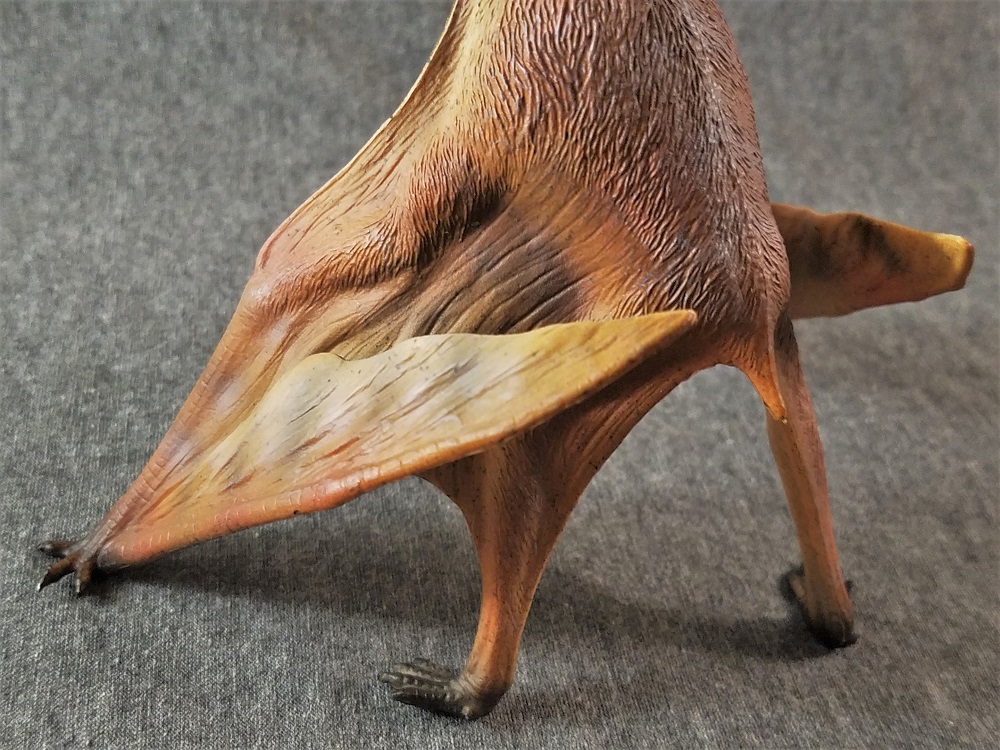
Overall this figurine appears to be a very fine representation of Quetzalcoatlus in many of the finer details; yet when it comes to the department of broader anatomical accuracy, the most integral and challenging aspect of this animal, the GR/Haolonggood figure actually falls short. Information about Quetzalcoatlus might seem confusing at first when studying the animal: there are in fact two distinct species within the genus, and full scientific descriptions to better distinguish them didn’t exist until very recently. The first species, Q. northropi, is the larger and more famous of the two; however it is only known from fragmentary remains, consisting mostly of a partial wing. The second species, Q. lawsoni, is much smaller* but known from nearly complete remains. The two species received a long-overdue, very thorough scientific description published in the Journal of Vertebrate Paleontology in November 2021. Most (or all) popular depictions of Quetzalcoatlus rely on the massive size of Q. northropi, but the actual appearance of the animal has to be extrapolated from materials for Q. lawsoni. With this in mind, a certain level of creative license is acceptable for GR Toy’s figure; but how carefully is it following what is known for sure of either species?
*”much smaller” being a relative term, as Q. lawsoni would have still stood taller than a man and bore a wingspan greater than the largest modern birds.
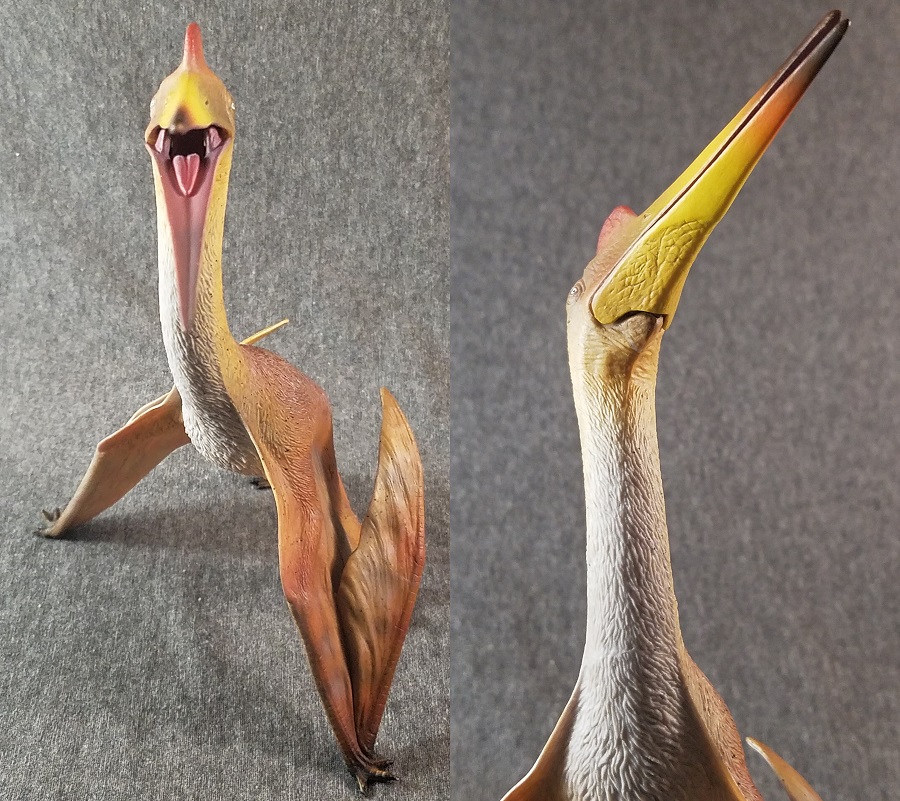
As one can probably notice while studying the photographs included for this review, the broader proportions of the figure are quite wacky. The head and neck are each longer than the entirety of the torso, with the slender-yet-sturdy limbs reaching equally long dimensions. If these proportions appear strange, your assumptions are correct – they should be even more extreme. What we know of Q. lawsoni and other large azhdarchid pterosaurs is that they were practically all neck and appendages, with almost no body. The Haolonggood figure is officially labeled as being 1:35 scale, but measuring different parts of the figure yield different results. Q. northropi is known primarily from the remains of a left wing, with a fossilized humerus measuring about 50 cm long. Based on the most recent skeletals by John Conway – produced for the November Journal 2021 papers – Q. northropi would have stood 2-2.5 meters tall at the shoulder. Although not quite posed in a straight stance, the shoulder-to-palm length of the GR Quetz’s arm measures roughly 8.5-9 cm (3.5 in) and the humerus appears to be around 2-2.5 cm. This puts the figure fairly comfortably in 1:25 scale, rather than 1:35 (the forearm and carpal bones are respectively too short and too long in proportions, but ultimately balance each other out in the total arm length).
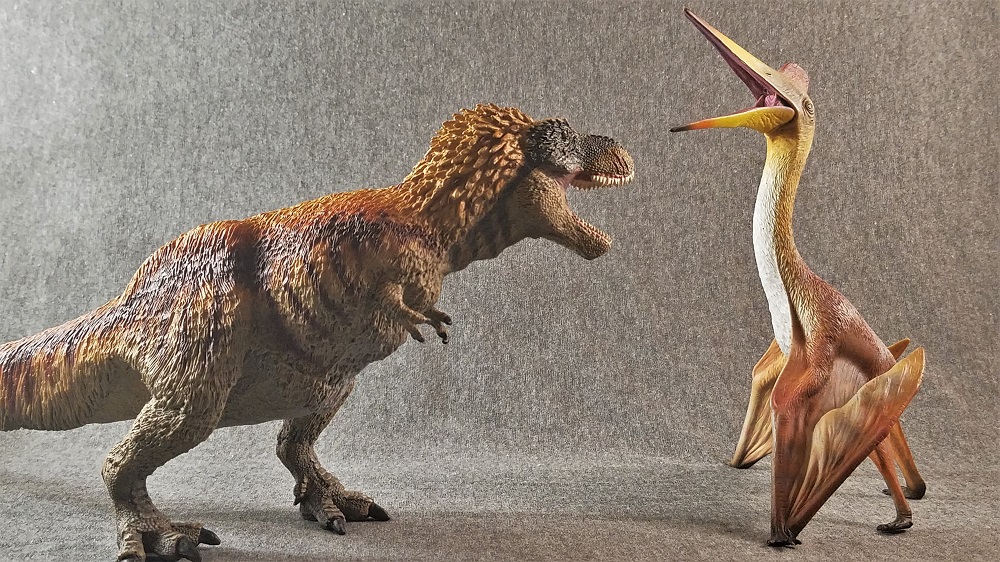
Other proportions on the figure are less consistent, with sometimes unexpected results. The head of the figure, measuring 8 cm (3.25 in), also matches estimates for a 2-meter skull in life at 1:25 scale. The torso, however, should ideally be almost half the size it already is; and the neck, even at 7 cm long, is significantly too short. Based on information extrapolated from Q. lawsoni and other azhdarchids, Q. northropi‘s neck may have stretched an extraordinary 3 meters in length – which means at 1:25 scale, the toy’s neck should be over 13 centimeters. This also means that, even if the figure was fully scaled down to 1:35, at proper body proportions the figure would still stand at nearly equal height of about 15-16 centimeters tall, just by merit of the sheer length of the neck. Naturally, this sculpt would have been finished well before the publication of Andres & Langston et al and Paidan et al. (2021); however, the figure is still incorrect when compared to Mark Witton’s previously existing skeletal, which runs very close to the dimensions illustrated in the latest papers. GR Toys and Haolonggood seem to have grossly underestimated just how outlandish azhdarchid proportions really were!

GR Toys’ and Haolonggood’s Quetzalcoatlus is an impressive-looking figurine, but it does have its shortcomings. The proportions of the figure are generic and imprecise for what is known of the genus, and the flimsy nature of the jaw articulation is questionable for what is meant to be a higher-end replica. The figure is otherwise well-made, and the promotional campaign with the unpainted figure was neat touch. Casual collectors should still find plenty to appreciate in this figure; however more ardent pterosaur enthusiasts hoping for a more definitive azhdarchid toy will have to keep waiting. As of this writing, the figure should be available for purchase on AliExpress and Amazon.
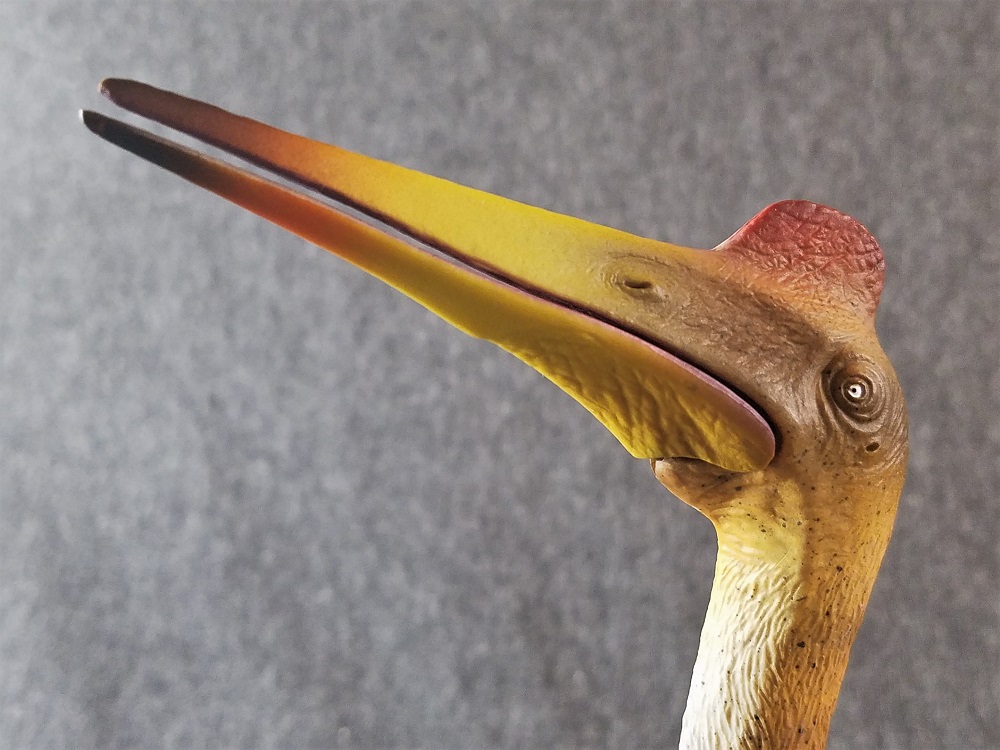
[note 2023/05/01: for the sake of accuracy I have updated some details regarding the companies involved in this toy’s production and release, as there has been confusion in the past regarding the relationships between GR Toys, Haolonggood, and MuSee studios.]
Disclaimer: links to Ebay and Amazon on the DinoToyBlog are affiliate links, so we make a small commission if you use them. Thanks for supporting us!



Nice review. The model does have problems with the articulation which is really annoying, surprisingly the unpainted version seems to hold its pose better at least on my copy.
Still a very nice and impressive model that displays well with the PNSO.
Considering how good their products can be, it’s really disappointing that this one has such wonky proportions and shoddy assembly.
My figure came with 2 missing toes which are nowhere to be found
Magnificent reversion, it is a magnificent sculpture but as mentioned, it is not definitive, honestly, its counterpart by Papo is more striking and interesting, although it is not as scientific.